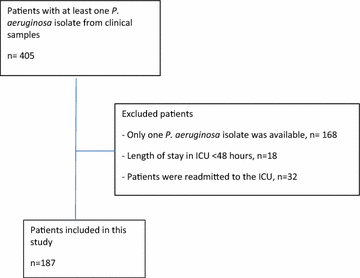Emergence of antimicrobial resistance to Pseudomonas aeruginosa in the intensive care unit: association with the duration of antibiotic exposure and mode of administration
- PMID: 28664350
- PMCID: PMC5491427
- DOI: 10.1186/s13613-017-0296-z
Emergence of antimicrobial resistance to Pseudomonas aeruginosa in the intensive care unit: association with the duration of antibiotic exposure and mode of administration
Abstract
Background: Antibiotics are frequently used in intensive care units (ICUs), and their use is associated with the emergence of bacterial resistance to antibiotics. The aim of this study was to investigate the association between the emergence of Pseudomonas aeruginosa resistance and the duration of antibiotic exposure or mode of administration in an ICU unit.
Methods: A 4-year cohort study of intensive care unit was performed in patients with P. aeruginosa isolates from clinical specimens, initially susceptible to the investigated antibiotics (piperacillin/tazobactam, ceftazidime, ciprofloxacin, meropenem and amikacin). Odds ratios (ORs) with 95% confidence interval (95% CI) of emergence of resistance were calculated using logistic regression analysis for various exposure periods to antibiotics (1-3, 4-7, 8-15 and >15 days) relative to no exposure with adjustment for age, sex, Simplified Acute Physiology Score 3 (SAPS 3) and length of stay. ORs on the emergence of P. aeruginosa resistance were also calculated for the various modes of administration.
Results: Included were 187 patients [mean age 61 years, 69% male, mean SAPS 3 score (SD): 59 (12.3)]. None of the antibiotics investigated showed the emergence of resistance within 1-3 days. Significant meropenem resistance emerged within 8-15 days [OR 79.1 (14.9-421.0)] after antibiotic exposure unlike other antibiotics (>15 days). No difference was observed between intermittent and extended administration of meropenem and between beta-lactam mono- or combined therapy.
Conclusions: Use of meropenem was associated with the emergence of resistance as soon as 8 days after exposure to the antibiotic.
Keywords: Antibiotic resistance; Extended infusion; Pseudomonas aeruginosa.
References
-
- ECDC. European Centre for Disease Prevention and Control. Point prevalence survey of healthcareassociated infections and antimicrobial use in European acute care hospitals. Stockholm: ECDC; 2013.
-
- ECDC. Antimicrobial resistance surveillance in Europe 2014. Annual Report of the European Antimicrobial Resistance Surveillance Network (EARS-Net). Stockholm: European Centre for Disease Prevention and Control; 2015.
-
- European Centre for Disease Prevention and Control. Antimicrobial resistance surveillance in Europe 2013. Annual Report of the European Antimicrobial Resistance Surveillance Network (EARS-Net). [Internet]. Ecdc; 2014. p. 1–211.
-
- Cobos-Trigueros N, Solé M, Castro P, Torres JL, Hernández C, Rinaudo M, et al. Acquisition of Pseudomonas aeruginosa and its resistance phenotypes in critically ill medical patients: role of colonization pressure and antibiotic exposure. Crit Care. 2015;19:218. doi: 10.1186/s13054-015-0916-7. - DOI - PMC - PubMed
LinkOut - more resources
Full Text Sources
Other Literature Sources


